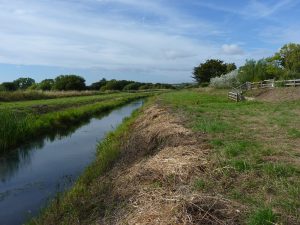Ferring Conservation Group had an interesting talk on Friday [27 September] from local resident Damon Block, a senior officer in the Environment Agency, about the organisation’s work managing the state of our rivers and coastal waters. Damon had begun there as a Water Bailiff, supervising fishing on our local rivers – still an important task of the Agency and a source of income from rod licences. Now he was looking after all the Sussex rivers from the Ouse to the Ems on the Hampshire border, for water quality, flood control and ‘abstraction’ by farmers for irrigation.
Water quality was gauged by the species of invertebrates of various kinds that could tolerate different levels of contamination and oxygen deprivation, as well as chemical testing. The problems arose not only from discharges and run-off but also from invasive plant species like Crassula and Himalayan Balsam, which could choke streams and destabilise banks.
The Ferring Rife, he said, was fairly easy to manage – quite a small catchment area, with few discharges, good flood defences, no fishing but plenty of wildlife. It had been good to see Water Voles getting established there. Other rivers like the Arun and the Adur were more complex both in their needs and threats, and the opportunities they offered for better habitat creation and the reintroduction of species like the otters on the Rother tributary.
Sussex had a good stock of fish in its rivers – eels were abundant here while declining nationally, and Sussex sea trout were the biggest and best in England. He explained that river trout and sea trout were the same species but had chosen different ‘lifestyles’ at an early age. Scales from these fish were, under a microscope, like sections of trees – showing measurable growth rings, evidence of how and where they had lived and spawned, and another good indicator of water quality.
A very interesting and enjoyable afternoon.
(Report written by Ed Miller)

